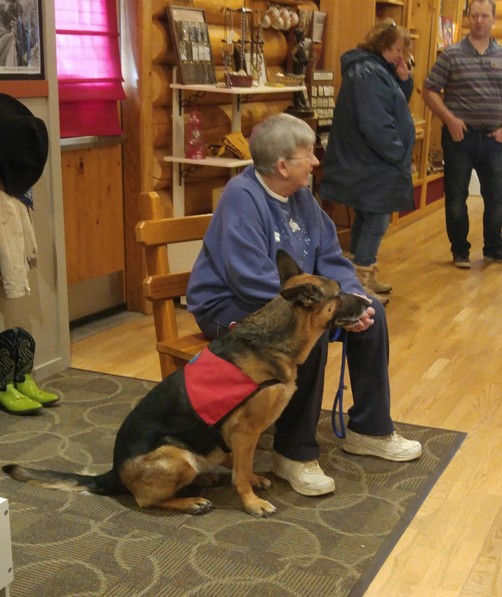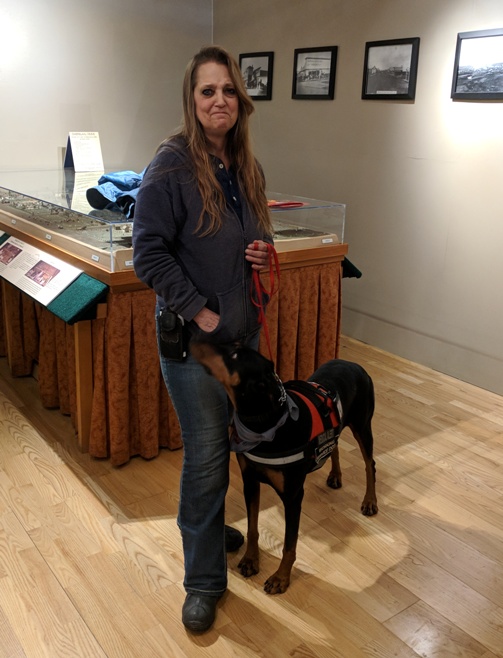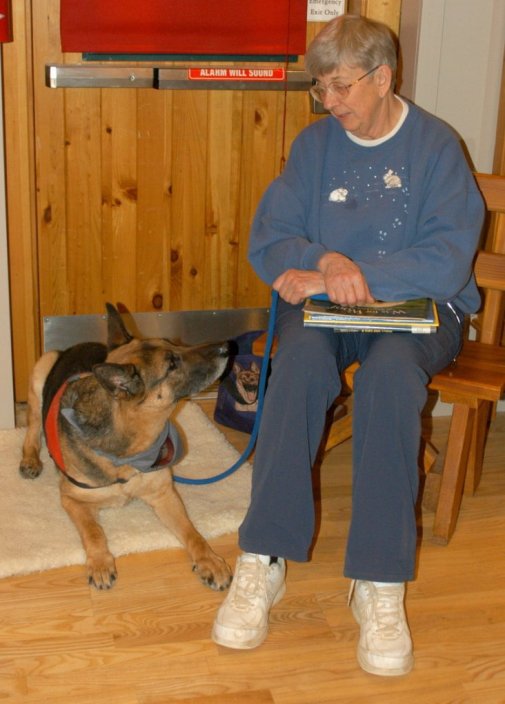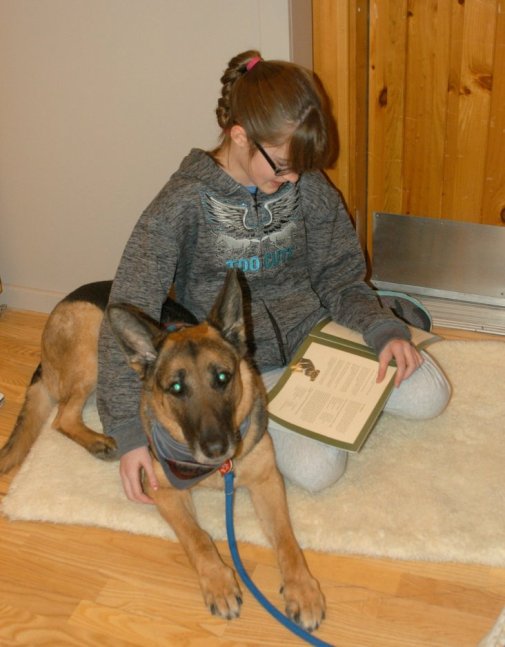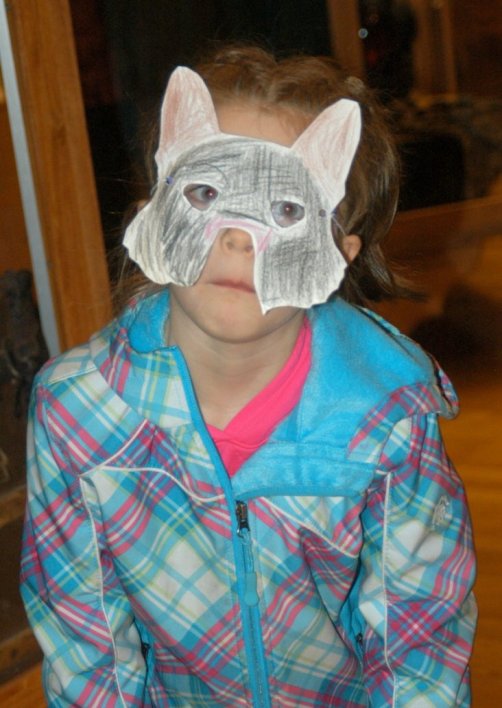Berakah at the Sheridan County Museum for Therapy Dog Presentation
for Tidbit Saturday, February 17, 2018
Photos by Erin Schock, museum staff member, and Judy Hagerott from Sheridan Media
I was contacted by the Sheridan County Museum and asked to do a presentation about therapy dogs for their monthly Tidbit Saturday program for kids. We planned that I would bring one of my therapy dogs, Berakah, give a presentation and then offer kids a chance to read to Berakah like we do at the Reading Dog Program at the Children’s Library. We also planned an activity – making dog masks. At my suggestion, the masks would have prick ears and look like German Shepherds rather than the original pattern which had floppy ears and spots. I borrowed books from the Children’s Library so that the children could choose what they wanted to read to Berakah. While most of the children worked on their masks, one could come to our station to cuddle and read to Berakah.
I educated the museum staff about the difference between a therapy dog (a volunteer activity where a handler shares her dog with people in need of comfort or stimulation) and a service dog (a dog which helps its owner, who has a disability, function more normally). Unfortunately, the museum director wasn’t there, and he was the one who sent publicity to the paper and radio station, and it said, “Cel and Berakah the service dog will be the presenters at our February Tidbit Saturday.” As soon as I read and heard the announcement, I called the museum and reiterated that therapy dogs ARE NOT service dogs and have no legal rights to go everywhere with their owners.
It was too close to the presentation to be able to do much media correction, so I also contacted Laurie Schwabauer, who not only has two therapy dogs and, like me, is a tester/observer for Alliance of Therapy Dogs, but also has two service dogs. Unfortunately, Jamboree, whom she got from me and who has been trained for many more tasks than her other service dog, was in season and couldn’t come. She and Hilda, her Doberman, were fortunately available that morning, so we quickly planned a dual presentation for Tidbit Saturday. Although Tidbit Saturday is specifically geared to young children, parents are required to attend, so the museum staff, Laurie and I planned to educate everyone on the difference between a therapy dog and a service dog.
When people arrived, they saw Berakah and I stationed at the entrance and were invited to visit and pet her.
Laurie and Hilda, meanwhile, were at a distance and both of us reminded children and parents that service dogs were not to be petted.
All of us then gathered in the presentation area, with Laurie, Hilda, Berakah and I standing in front. I gave my presentation about therapy dogs and Berakah really played the part, inviting the children seated close to her to pet her as I talked (unfortunately no one took a photo of my presentation). I talked about therapy dogs visiting hospitals, nursing homes, disaster areas, homeless shelters, airports and of course our Reading Dog program. I discussed the screening process for new teams, where the dog is evaluated to be sure it’s well mannered enough to be around fragile people and the handler is an active team member, correcting when necessary and praising when the dog does well. The dog just needs basic obedience skills to be accepted as a therapy dog. After passing the screening, the prospective team then must do three visits to a medical facility or other place where therapy dogs work, supervised by the tester/observers. After that, they submit the test, our comments on the supervised visits and their application form to Alliance of Therapy Dogs. If ATD approves them, they become a registered therapy dog team, receive liability insurance and a “I am a Therapy Dog” tag which is their official badge, and are able to begin scheduling visits to whichever institution where they want to volunteer. ATD members may also purchase vests for their dog to wear but they are not required. Therapy dogs do not have any special privileges, especially those given to service dogs under the American Disability Act (ADA), such as entry to all business and public places, traveling in airplane cabins with their owners and so on.
I then sat down and Berakah chose a place to lie next to the children while Laurie gave her presentation and described service dog tasks such as giving medical alerts, helping with mobility issues or panic disorders, and so on. In order to qualify for a Service Animal, a person must fit the definition of being legally disabled and the animal must aid them by performing a major life activity. The ADA defines a Service Animal as any Guide Dog, Medical Alert Dog or Mobility Assistance Dog that is individually trained to provide assistance to an individual with a disability as long as the person’s disability falls under the ADA’s definition of physical or mental impairment or condition. For more information regarding the ADA, see their website, www.ADA.gov.
Laurie described the rigorous training, usually 18 – 24 months worth, that a prospective service dog undergoes. Laurie has trained both her service dogs and trains other people to train their dogs as personal service dogs. The process may differ for other service dogs such as guide dogs, but ALL service dogs must go thorough vigorous training. Not only does the dog need impeccable obedience, it must learn a variety of tasks needed by its owner, the number and complexity of those tasks being determined by the owner’s disability. So called emotional support dogs go not go through significant training, are NOT service dogs and are not covered by ADA privileges.
Service dogs perform some of the functions and tasks that the individual with a disability cannot perform for himself or herself alone. Examples include “alerting” people with hearing impairments to sounds, carrying and picking up things for people in wheel chairs and helping those suffering from hidden disabilities with mental impairments by tactile simulations or buffering in large crowds.
Generally, a person with a service dog keeps a detailed training log, entering each time a dog is worked, where it was worked and what obedience or task was trained in the session. The AKC Canine Good Citizen Test is not required but recommended before going on to public access training. Passing it signifies that the dog and handler are prepared for public access and the dog can then wear a “Service Dog in Training” vest. The service dog in training with its handler then trains and passes the other two phases of the Canine Good Citizen Program, the CGC Advanced and the CGC Urban tests which helps the team prepare for the final phase of their training, the Public Access Test. The handler keeps a log, proof of tests, videos of Public Access Test and the dog performing at least three tasks for its owner if ever a legal question ever arises. The handler also keeps a letter from their doctor stating their need for a service dog and the dog’s health records in their car or on their person as proof that the dog is actually a service dog if access to a business is questioned. The dog generally wears a vest identifying it as a service dog.
Laurie then explained what particular duties Hilda performs for her and why someone petting Hilda could distract her from her work.
Erin, from the museum staff, had gathered photos of therapy dogs working and service dogs working and after each of our presentations gave them to us, and we explained a little about what each dog was doing in the photo before handing it to the children to pass around. Laurie and I have inspected the photos beforehand to be sure they clearly showed the difference between the two types of work.
After we fielded questions from the group, the staff set up everything for the mask-making activity while Laurie chose a position away from the group but handy for anyone having questions about service dogs. I, meanwhile, set up Berakah’s reading station just like we do for Reading Dog at the Children’s Library. She has a rug on which she lies and children can choose to sit next to her or at a distance as they prefer. Several children accepted the invitation and enjoyed a peaceful reading session with Berakah. A reporter from Sheridan Media interviewed both of us and took several of these photos. A nice synopsis of our presentation is posted on SheridanMedia.com.
Meanwhile the children enjoyed their mask project, and some even colored the mask to look like a German Shepherd! Their parents browsed through the handouts we had for them to take – copies of the quarterly magazine and other items I had gotten from ATD, and pamphlets on service dogs provided by Laurie.
The museum presented Hilda and Berakah with scarves.
Eventually everyone left. What I had been told would be a maximum of an hour stretched to nearly two hours before everyone finally left. We called it a success!
In their Christmas 2019 card, the owners of one of my PP litter included this poem they had written, which I just had to add to this page.
Cel and her Kids
There is a lady named Cel
To her Shepherds she’s a big deal
But even greater to all
Whether the big or the small
Special pleasure she gives
When visiting with her kids
The different locations
Schools, infirmed and the aging
Happy thoughts throughout
With Shepherds have no doubt
Whose unending devotion
Keeping life in full motion
Enlightening all the hearts
Is the big gift Cel imparts!
Thanks, John & Julie, for those beautiful thoughts.
***
More information on Therapy Dogs
More information about the Reading Dogs program at the Children’s Library

